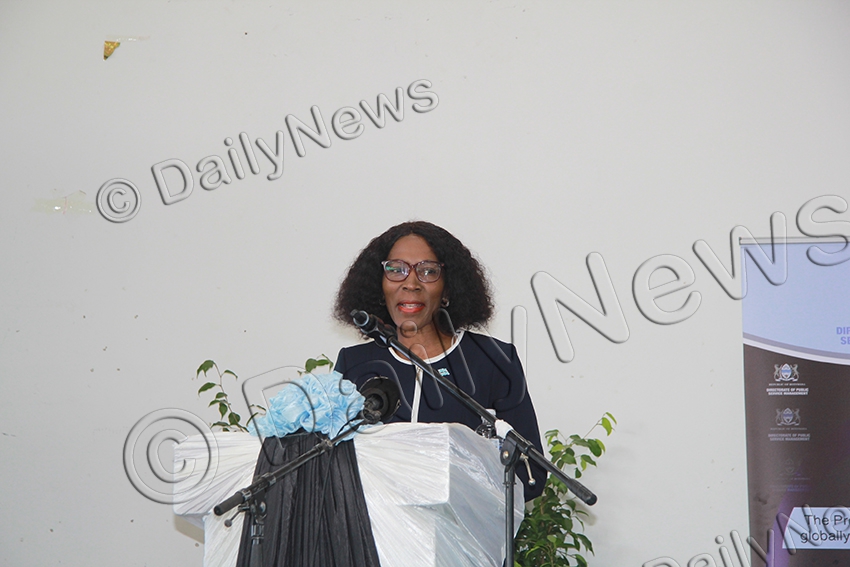DPSM moves to implement fan-shaped structure
23 Jul 2024
The Directorate of Public Service Management (DPSM) is laying out foundations for implementation of the proposed fan-shaped salary structure, aimed at addressing productivity and progression of public sector employees.
Speaking during a consultative meeting with public service employees in Lobatse on Monday, DPSM director, Ms Gaone Macholo explained that the new structure would have broad salary scales of around 25 notches compared to the current narrow scales of 10 notches or less.
She said the broad scales would prevent stagnation of employees and reward good performers as they would be able to move continuously up the notches without reaching the ceiling quickly.
She pointed that consultations were progressing smoothly with relevant stakeholders including labour organisations. She therefore expressed confidence that after completion of consultations and other processes, the new salary structure would be implemented next year.
She said the idea of a fan-shaped salary structure started in 2018 after government engaged some consultants, commonly referred as PEMANDU, to review and make recommendations on how the public service structure could be improved.
In 2022 the DPSM reached agreement with workers’ unions to implement the recommendations the PEMANDU consultants.
“We agreed to implement the fan shaped salary structure where the scales will be overlapping and employees will move within their salary scales for many years without reaching the ceiling. Currently, employees reach the top notch after 10 years. There are many employees who have reached the top notch and have nowhere to progress because there are limited posts for promotion to the upper scales. Therefore, the fan-shaped salary structure will prevent stagnation of employees,” she said.
Ms Macholo said however said progression of employees through the notches would be based on good performance. She said employees that failed to produce satisfactory performances would not progress to the higher notches.
“The fan-shaped salary structure will enable us to align progression of employees with their performance at work,” she said.
Ms Macholo said current statistics indicated that over 50 per cent of public service employees were stagnant after reaching top notches.
Ms Macholo further said DPSM was in the process of consolidating and harmonising all pieces of legislation relating to the public service sector.
She said the process was aimed at effective operation of the public service. She said those pieces of legislation included the Public Service Act of 2008, the General Orders of 1996, the Employment Act and the Trade Unions Act.
“We have realised that some of the provisions of our Public Service Act do not align with the Employment Act. Hence we have found it necessary to align these two legal instruments. We have also realised that our General Orders are older than the Public Service Act which is an anomaly,” she said.
Further, Ms Macholo pointed that the consolidation and harmonisation process would result with only two pieces of legislation for the public service being the Employment and Labour Relations Act and the Public Service Act.
She said the Employment Act and the Trade Unions Act would be combined into the Employment and Labour Relations Act. She further said the General Orders would be renamed Conditions of Service.
Ms Macholo said they had already taken the proposed pieces of legislation to the Economic Committee of Cabinet.
‘We have also reached agreement with unions to develop various policies out of the General Orders such as the Disciplinary Policy, the Occupational Safety and Health Policy, the Recruitment, Selection and Appointment Policy (inclusive of transfer guidelines), the Learning and Development Policy, the Performance Management Development Policy, the Overtime Management Policy, and the Conditions of Service Policy,” she said.
DPSM Compensation and Benefits officer Ms Olebogeng Yane, pointed that the current pay structure which was developed in 1988 was too old and required to be modernised. Ms Yane said the new fan shaped structure would help to motivate employees and improve performance.
"This fan shaped structure will be a facilitator of performance and competitiveness within the public service. We want to attract and retain talent within the public service through competitiveness," she said.
She said the challenge of the current structure was its limited range which leads to promotion pressure and complexity in administration.
She said 60 per cent of employees on A1 scale and 47 per cent on B1 had reached top notches.
“The fan-based structure will help us to move from the narrow range to a broad range of salary scale,” she said.
However, Manual Workers Union consultant, Mr Johnson Motshwarakgole pointed that further consultations were still required between workers’ unions and DPSM on some issues relating fan-shaped structure.ENDS
Source : BOPA
Author : Jeremiah Sejabosigo
Location : LOBATSE
Event : consultative meeting
Date : 23 Jul 2024







